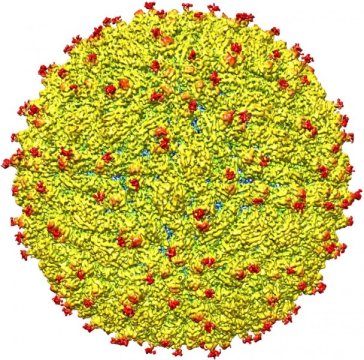A team of researchers led by Purdue University scientists Michael Rossmann and Richard Kuhn is the first to determine the structure of the Zika virus, which reveals insights critical to the development of effective antiviral treatments and vaccines. Related study was published online this week in the journal Science.

Zika virus is an emerging mosquito-borne flavivirus closely related to dengue virus. It was first isolated in Central Africa, and has since been spread to South Asia and recently to South America. It can cause mild fever, rash, myalgia, arthralgia and headaches, with one in four infected individuals being asymptomatic. Due to similar symptoms Zika virus infected individuals can easily be mis-diagnosed as a dengue infection and vice-versa. In addition, Zika virus has been implicated in causing microcephaly through transmission in utero.
The ongoing Zika virus epidemic is of special concern because of apparent links to congenital microcephaly, a medical condition in which the brain does not develop properly, resulting in a smaller than normal head, as well as the autoimmune-neurological Guillain Barre syndrome.
To learn more about the structure of the virus and possible ways to therapeutically target it, Dr. Rossmann, Dr. Kuhn and their colleagues used cryo-electron microscopy to analyze a strain isolated from an infected patient during the French Polynesia epidemic in 2013-14.
“We were able to determine through cryo-electron microscopy the virus structure at a resolution that previously would only have been possible through X-ray crystallography,” Dr. Rossmann said.
“The structure of the virus provides a map that shows potential regions of the virus that could be targeted by a therapeutic treatment, used to create an effective vaccine or to improve our ability to diagnose and distinguish Zika infection from that of other related viruses,” said Kuhn, who also is head of Purdue’s Department of Biological Sciences. “Determining the structure greatly advances our understanding of Zika — a virus about which little is known. It illuminates the most promising areas for further testing and research to combat infection.”
The analysis reveals that the structure of Zika virus is very similar to that of other flaviviruses, and particularly similar to dengue. The scientists also identified regions within the virus structure where it differs from other flaviviruses. According to the research, the difference is in a region of the E glycoprotein that flaviviruses may use to attach to some human cells.
The variation in the E glycoprotein of Zika virus could explain the ability of the virus to attack nerve cells, as well as the associations of Zika virus infection with birth defects and the Guillian-Barre syndrome.
The structure could inform vaccine development, as the Zika E glycoprotein is a key target of immune responses against the virus. The information may also be useful for designing treatments such as antiviral drugs or antibodies that interfere with E glycoprotein function.
Further, details on the structural differences between the Zika E glycoprotein and the same protein in dengue virus may make it possible to create diagnostic tests that can distinguish Zika virus infection from dengue infection, a critical need in countries where both Zika and dengue viruses are circulating.
Journal Reference:
D Sirohi et al. The 3.8Å resolution cryo-EM structure of Zika virus. Science, 2016 DOI: 10.1126/science.aaf5316
Story Source: sci-news.com
